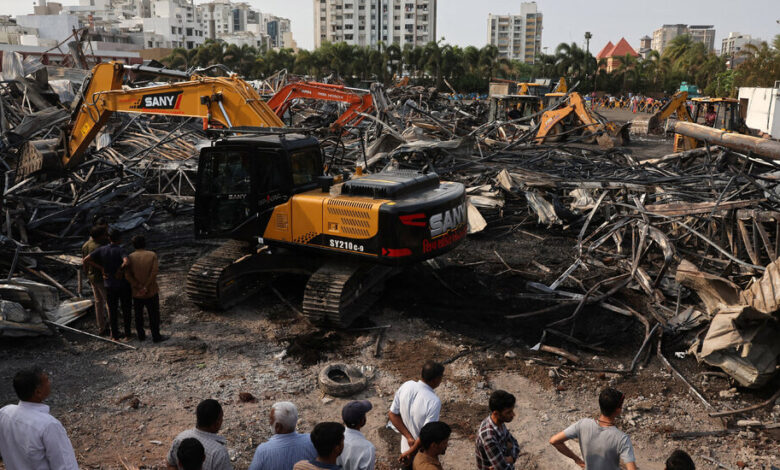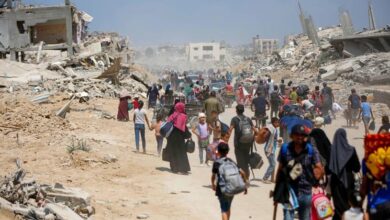Deadly fires highlight India’s safety deficit

Seven newborns have died after a neonatal clinic in New Delhi was engulfed in flames. What remained of the two-story building Sunday morning was a burned-out facade, a charred spiral staircase and oxygen tanks covered in soot.
Hours earlier, in the western Indian city of Rajkot, an amusement park with trampolines and bowling alleys turned into hell. Families of those who came to enjoy discounted all-you-can-play rides to celebrate the start of the summer holidays have struggled to identify the bodies of at least 27 people who died, many of them they were children charred beyond recognition.
As follows each such deadly episode, political leaders are quick to issue messages of condolence, announce arrests, launch investigations – and point fingers. But for analysts and experts who have warned for years about India’s poor fire preparedness, Saturday’s back-to-back disasters were the latest reminder that Systemic changes to make the country safer have yet to be implemented.
Construction safety compliance remains very limited across India, the world’s most populous country. Fire services have long faced huge gaps in station numbers, staffing and equipment. Government audits after mass-casualty disasters have found glaring shortcomings but have had little follow-up.
Although the number has decreased over the past decade, more than 20 fire-related deaths still occur every day in India, according to government statistics. Many fires – especially in dense urban centers – are caused by electrical short circuits, an alarming prospect as India faces a period of intense heat that strains electrical wires.
RC Sharma, former chief of fire services in Delhi, said that a major problem was that fire regulations were not enforced. Another problem is that fire response resources have not kept up with the rapid pace of urbanization, often without regard to safety.
“We are in a bad situation,” Mr. Sharma said. “In other countries, you have fire hydrants and things everywhere. But in India, we don’t even have drinking water round the clock, so we don’t think about having water for firefighting round the clock.”
Data provided to the Indian Parliament in 2019 of the country’s Interior Ministry painted a dire state of preparedness, with major shortcomings. India has only 3,377 fire stations when regulations require 8,559. Shortages in personnel and equipment were even worse. The fire department had about 55,000 people, when half a million were needed, and 7,300 vehicles, when there should have been 33,000.
It’s unclear how much of the gap has been filled in the five years since. A new $600 million program to expand and modernize the fire service announced by India’s central government last year, with additional resources mobilized from the states, shows that much of the program program has not yet been implemented.
Government audits have repeatedly pointed out the weaknesses of public buildings, especially hospitals.
ONE learn Last year, the number of hospitals across India that had suffered fires in the past decade showed that half were not legally compliant with safety measures. Public and private hospitals are equally bad. Short circuits are the cause of fires in nearly 90% of episodes.
In one state, after a fire killed 10 babies in a neonatal care unit, assessments found that more than 80% of the state’s hospitals had never performed a fire safety inspection; half had never conducted a fire drill; and only a few have fire safety certificates.
“The tendency to comply is in the letter, not the spirit,” said SA Abbasi, professor emeritus at Pondicherry University and lead author of the report. “Errors and laxities continue to be the norm rather than the exception.”
It is unclear what caused the fire at an amusement park in Rajkot, Gujarat state. But the initial police complaint, a copy of which was seen by The New York Times, made clear that the facility lacked both a fire department clearance certificate and effective equipment and procedures in the event of a fire. fire.
Ilesh Kher, chief fire officer of Rajkot, said the fire at the facility started just before 6pm and it was brought under control after more than an hour. He did not know how many people were present when the fire broke out, but witnesses on local news said there were more than 100 people.
The building appears to be a temporary structure made of iron columns and metal panels.
Daksh Kujadia, a teenager who went bowling with a cousin, said the fire started from the fire escape. About 30 people were trapped in the bowling alley.
“We had no choice but to tear the sheet metal into a corner,” he said. told local media. “Fifteen of us escaped by jumping from there.”
The two-storey neonatal hospital in Delhi caught fire just before midnight operating outside a residential building. Neighbors described frequent disputes as trucks often blocked the road outside the hospital to unload large oxygen tanks.
“Some of us climbed on top of each other and climbed into the building from behind the building,” said Ravi Gupta, who lives in the area and helped evacuate dozens of children from behind the building. An explosion was heard as the oxygen tank exploded. “We brought ladders and bedsheets from our home. I took the babies in my arms out of the fire and brought them down.”
The healthcare system in Delhi, India’s capital, has in recent years been in shambles political struggle between Prime Minister Narendra Modi’s central government and Delhi’s elected local government, run by a smaller opposition party, the Aam Aadmi Party, or AAP. Local authorities have accused Modi of using his control over government officials to hinder their efforts.
Accusations continue to fly after Saturday’s deadly hospital fire.
Pankaj Luthra, a local official affiliated with Modi’s party in the neighborhood where the hospital is located, blamed AAP for granting the license to the hospital. He said there had been complaints about illegal refilling of oxygen tanks at the hospital.
Saurabh Bhardwaj, AAP’s Health Secretary in Delhi, issued a report declare complained that the top official of the Delhi health department – a civil servant who is technically supervised by Mr. Bhardwaj, but in fact answers to the central government – ignored his calls and messages.
Mr. Bhardwaj said: “I learned about this incident through the media.




